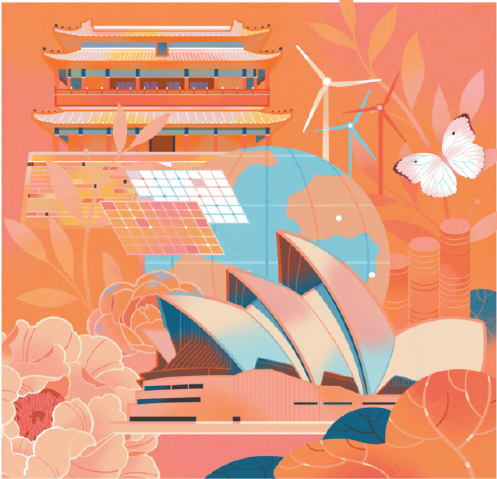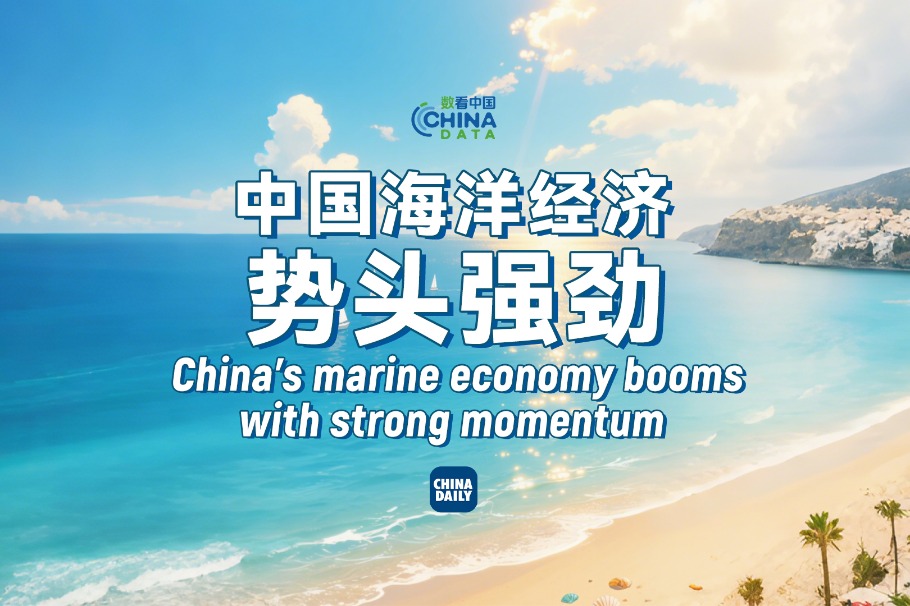Reenergized ties


Green industry cooperation injects new impetus into Australia-China relations
The global green transformation has been reshaping international economic structures and cooperation paradigms. A case in point is the Australia-China relationship. Australian Prime Minister Anthony Albanese visited China in July and both countries signaled deeper engagement in the green industry sector. The Australia-China relationship is evolving beyond traditional resource trade to encompass low-carbon technologies and the joint development of green industry chains, emerging as a key driver in enhancing both the quality and efficiency of bilateral relations.
Trade remains a "ballast stone" of Australia-China relations, and in recent years, especially after the COVID-19 pandemic, it has surged. In 2024, bilateral trade reached $211.5 billion, of which China accounted for around 32 percent of Australia's total exports. But this trade is heavily dominated by carbon-intensive products. In 2024, roughly three-quarters of this trade was in carbon-intensive commodities such as iron ore, coal and natural gas.
But as China advances its dual carbon goals, the volume of such carbon-intensive trade is declining. For example, Australia's exports of metallurgical coal to China has fallen sharply over the past five years. In contrast, Australia's exports of critical minerals such as lithium to China have grown, becoming essential inputs for China's clean energy supply chains. On the other side, China's exports of photovoltaic modules, wind power equipment, and other green technologies to Australia have increased substantially. Notably, Goldwind Science &Technology has supplied around 2 gigawatts of wind power equipment to Australia and has developed large-scale projects, including the 530-megawatt Stockyard Hill Wind Farm — currently the largest operational wind farm in the Southern Hemisphere.
Beyond green trade, investment in the green economy offers major opportunities to deepen bilateral ties. Despite recent challenges, including regulatory and geopolitical headwinds — evidenced by China ranking only 13th among sources of foreign direct investment into Australia, green investment is starting to shift. Chinese investment is gradually moving away from traditional sectors such as coal and iron ore toward photovoltaics, wind energy and hydrogen.
One example is the Wollar Solar Farm project, developed by Beijing Energy International, with a total installed capacity of 280 MW. Once fully operational, it is expected to generate over 600 million kilowatt-hours of electricity annually — enough to power 100,000 households, and reduce carbon emissions by about 500,000 metric tons per year.
Australian companies are also contributing to China's green transition through financial instruments and technology exports. ANZ Bank, for instance, has participated in a sustainability loan to Geely Automobile to support its R&D in new energy vehicles. The bank's portfolio now includes green bonds and sustainability-linked guarantees — financial tools tied to specific decarbonization targets, providing an emerging model for green finance innovation. These evolving investment patterns point to new directions for future collaboration.
Sustained cooperation in the green sector relies on robust institutional frameworks. It should thus not be a surprise that a key outcome of Prime Minister Albanese's visit was the announcement of a steel decarbonization policy dialogue — a mechanism for bilateral climate cooperation that aims to facilitate policy alignment on emissions reduction, sustain official-level engagement on environmental issues, and support joint technological R&D in the steel sector.
Signaling the importance of industry participation, several CEOs from Australia's major mining companies accompanied the prime minister. Global mining giant BHP signed memorandums of understanding with CATL and FinDreams Battery (a BYD subsidiary) to co-develop battery systems for heavy-duty mining trucks and locomotives in Western Australia, along with supporting flash-charging infrastructure. This collaboration aims to decarbonize mining logistics and operations at scale.
As the green transition accelerates, it will be crucial to maintain policy momentum — especially through deeper consultations on regulatory alignment, green standards and investment facilitation. For instance, China and Australia could expand green finance instrument development, such as green steel or green iron certificates. These would be similar to renewable energy certificates. These certificates would allow for green iron or steel producers to sell the certificate to interested "green "buyers independent of the steel product itself in order to generate extra revenues for the necessary investment. Furthermore, China and Australia could strengthen research and development collaboration on green iron and green steel processing to accelerate deployment. Finally, foreign investment review agencies of both sides should strengthen communication and increase the transparency of approval procedures to promote the sustained and healthy development of China-Australia investment cooperation.
The trajectory is clear: Australia-China green industry cooperation is shifting from a model of resource complementarity to one of joint value creation across green industry chains. From the two-way flow of photovoltaics and wind turbines to co-developing green steel technologies and hydrogen supply systems, bilateral cooperation is being reshaped by shared climate goals and economic interests. Strengthened institutional dialogue can anchor this momentum and serve as a vehicle for broader systemic change.
If this model of structured, green-oriented cooperation proves successful, it will not only inject fresh impetus into the economies of both countries, but also stand as a compelling example of international cooperation in the global low-carbon transition.
Christoph Nedopil is director and professor at the Griffith Asia Institute at Griffith University in Brisbane, and director and visiting professor at the Green Finance & Development Center at the International School of Finance at Fudan University. Wang Wenjun is an associate research fellow at the Institutes of Science and Development at the Chinese Academy of Sciences. The authors contributed this article to China Watch, a think tank powered by China Daily. The views do not necessarily reflect those of China Daily.
Contact the editor at editor@chinawatch.cn.


































